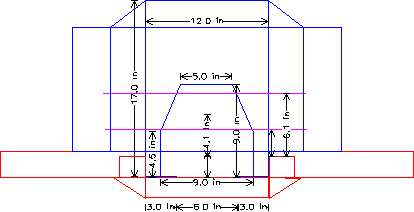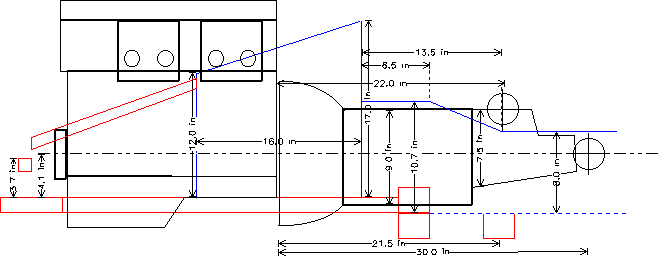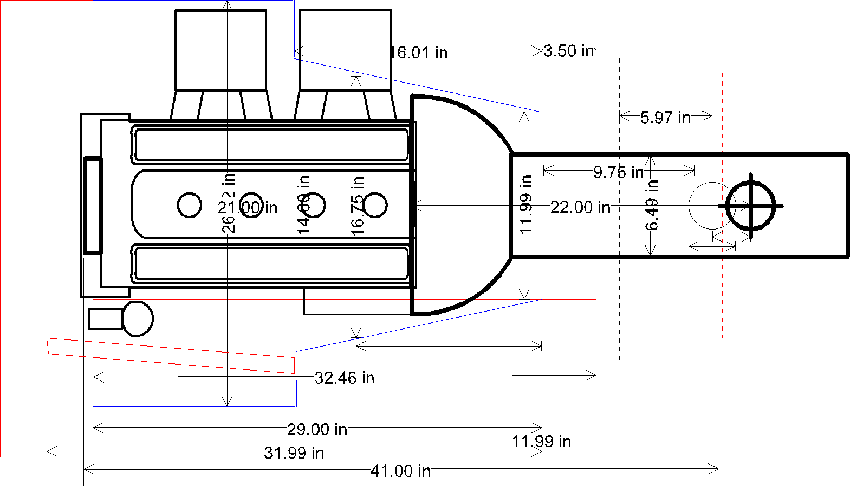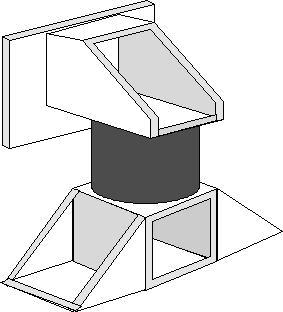

Any additional reconstruction such as de-rusting, panel work, or suspension and/or brake maintenance should be done before any modifications are undertaken.
Remove the engine and gearbox as described in the Haynes manual. I have found that engine removal is facilitated by also taking off the front panel that carries the bonnet latch, as well as the grille and front valance.
Unbolt the steering rack and push it down to rest on the frame rails. This not only provides an additional inch-and-a-half of clearance as the engine slides out, but also protects the rack from injury should your engine hoist slip.
Remove the old motor mount rubbers and mount pedestals. These will not be used.
Once the engine bay has been stripped, the two radiator uprights are cut off and ground smooth down to the frame rails. The new Corolla radiator will require much wider supports that are angled to the rear.
In order to obtain an additional 2" (50mm) of vertical clearance for the new transmission, the original frame crossmember that passes in front of the seats and extends from sill to sill under the gearbox must have its center section removed where it bridges the transmission tunnel.

The new crossmember section is shown in the figure and welded as illustrated. This must be done before the old section is removed so as to keep proper chassis alignment. A length of 2"x3" .120 wall (50mm X 75mm, 3mm) box-section tubing is cut to overlap about 4" (100mm) on each side of the tunnel opening. This tube is end-capped and welded to the bottom of the crossmember.
The old section is then removed either by torch or saber saw The resulting open ends are capped-off to prevent moisture collecting in the exposed tubes. Once the old section has been removed, about six inches (150mm) of the tunnel floor behind the new section should be cut back. The Toyota transmission is much taller in this area than the BMC unit.
The new gearbox crossmember is bolted, through the floorboard, to two 2"x2", .120" (50mm X 50mm, 3mm) square-tube legs that extend from the crossmember backwards. These legs are necessary to transfer the load from the rather thin floorboard material to the main crossmember.
A stock Toyota transmission mount and crossmember are used.
Depending on which engine is used, various different modifications may be needed to the right footwell. The following describes those operations needed to fit a 2TG with sidedraught Mikunis, as this is probably a worst-case application.

A area approximately 6"x6"x2" (150x150x50mm) needs to be removed from the upper, inside corner of the footwell to clear the rear carburetor. A suitable sheetmetal box is formed to block this opening and welded in.

In some cases a hole approximately 6" (150mm) long by 4" (100mm) high is cut in the lower, inside of the footwell to clear the clutch slave cylinder and to provide access for maintenance and bleeding.
The most involved modification has to do with the forward section the transmission tunnel. The Spridget tunnel is asymmetrical with the more pronounced bulge being on the right. In order to fit the wider Toyota gearbox, the tunnel must be made symmetrical by cutting open the left side and adding a new wall and top.
An area just behind the transmission fill hole, extending back to the new gearbox mount, and from the top of the tunnel to the floorboard is removed.
This area is cut with either a saber-saw or carefully with a cutting torch and the edges dressed. Be careful when cutting as the brake line passes inside this section of tunnel. If using a torch, have fire extinguisher handy, as there usually is quite an accumulation of grease in the tunnel and it is very easy to set it alight.
Two templates are made to cut the new sheetmetal. The first is made by laying a piece of pattern board against the right side of the tunnel, flush to the floor, and tracing the outline of the top curve of the tunnel. This pattern will be used to cut the new left side tunnel piece. The second template is drawn by laying the pattern material on the top of the tunnel with one edge aligned with the center seam of the tunnel. the left side curve then traced to this pattern. This template is used to cut a new tunnel top. This template is laid on the sheetmetal in the original orientation, traced, then flipped over to draw the new right edge. Once these new panels are cutout, they can be held in position with pop-rivets or Clecos, ready for welding.
It is important that these panels are stitch-welded into position to minimize distortion.
Remove the battery along with its plastic drip-tray and holddown. Disconnect all wires leading to the starter solenoid and remove.
If you are installing a T-block rather than a A-block, the heater tray will have to come out. Because of the length of the T-block, the heater/battery shelf must be shorted by about 4" (100mm).
It will be necessary to relocate the battery to the boot, as discussed later.
The shelf is removed by drilling out the spot-welds and prising the flange away from the footwell. I have found this is made easier by first cutting out the bulk of the center of the shelf with a rotary cutter or saber-saw.
A new shelf is bent from 18g or 20g sheetmetal with the heater opening to the rear of the shelf, next to the firewall. Captive nuts are spot-welded to the inside of the shelf for the heater box screws.
The forward heater ports that originally directed air into the interior through the control flaps, are blocked-off by plates welded over the opening. Before these are welded closed, make a template of the opening in order to transfer this shape to the new port location. The location of the new port will be just behind the defroster holes. Replicate to shape of the original holes and screw the old control flaps over the new ports. The defroster requires no modification.
The motor mount isolators used are standard GMC units as fitted to Chevette and light duty trucks. These are simply a round rubber block about 2" (50mm) tall and have a 3/8" stud on one side and a 1/2" stud on the other.
New motor mount pedestals are formed from 2"x2", .120 wall (50mm X 50mm, 3mm) square tubing. and welded to the top of the forward chassis arms. It best to temporarily locate the engine and gearbox with the mount rubbers bolted to these pedestals. Once the engine assembly is centered in the engine bay, the pedestals are tackwelded in place. Pull the engine and finish welding the pedestals to the chassis.

New engine-side motor mount brackets are made from 3/8" (10mm) mild steel plate and 2x2 (50x50) square tube. See figure.
To prepare the engine for installation, remove the alternator, A/C compressor, and their brackets.
Fit the clutch slave cylinder and hose to the gearbox. Remove the carburetors and manifold, exhaust manifold, and distributor. This is to allow more maneuvering room and to prevent damage to these items during installation.
In some instances, the dual sheave crankshaft pulley may foul the front lower crossmember. If this is the case, an early single-pulley type can be substituted. These are completely interchangeable. Note, this problem will not arise when using a shorter A-block engine.
